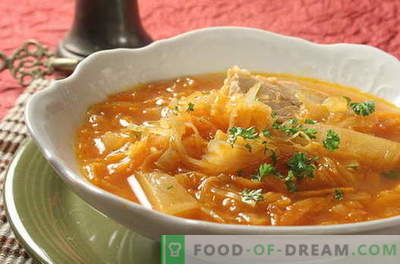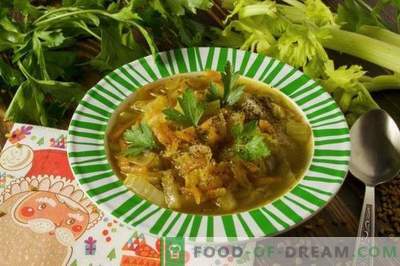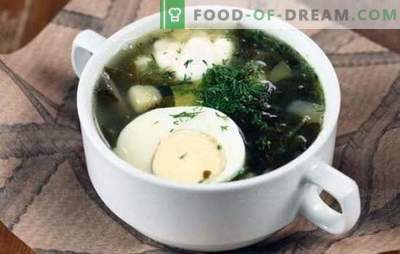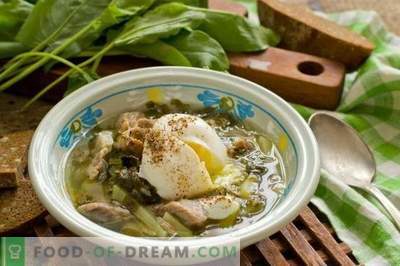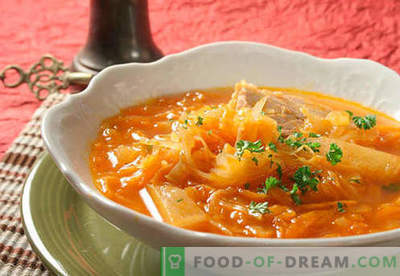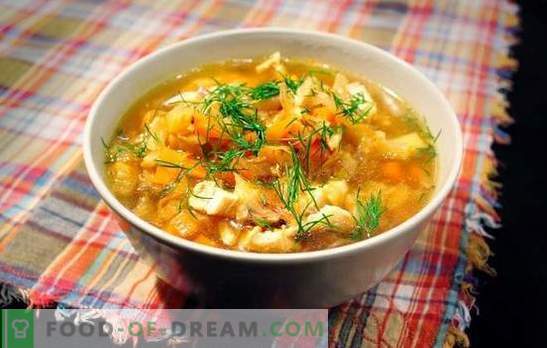
We can confidently say that soup is only a Russian dish, because no foreigner can clearly pronounce this name, and in special foreign literature, soup is called cabbage soup, and its recipe is found in cookbooks extremely seldom.
One can study history, geography and literature from schim, from oral folk art to the works of the great Russian classics.
Every housewife knows a couple of soup recipes that were prepared by her mother and grandmother. But this is within the framework of a single family, in a particular locality. In the neighboring region, they may be prepared differently, and on the outskirts of immense Russia, where Russian traditions and culture are closely intertwined with the traditions of other nations, the differences in cooking are sometimes surprising.
If we push the boundaries of time and space, then the soup is much more interesting, which we will now try to understand in more detail and using examples.
Sauerkraut soup with pork - the main technological moments
The basis of cabbage - cabbage. So it was led from the ninth century, when they began to cultivate this vegetable in Russia. In summer and autumn - fresh leaves, in winter - sour, pickled. There are recipes of soup with sorrel, nettle, and other greens. But sauerkraut is the calling card of an old Russian dish.
Old recipes of cabbage soup differ by minimalism. In them, except cabbage, there are very few herbs and roots. Later, spices were added to the soup, but in small quantities. Until the sixteenth century, the soup was more like a drink. Meat and fish products gradually grew to the vegetable base.
Soup on the basis of meat or fish broth in the old Russian cuisine was a privilege of the nobility. Poor peasants could afford such luxury only on large Orthodox holidays: Russian cuisine was formed not only under the influence of neighboring states and traditions of other nations, but had social stratification, and was largely oriented towards the observance of Orthodox canons. Therefore, there are still varieties of cabbage soup:
- Rassadnye - using young cabbage leaves;
- Green - from nettle, sorrel and other leafy greens
- Lenten - with mushrooms, beans, etc .;
- Fish - this kind of soup is rarely prepared, as for good fish broth, the use of sturgeon and several species of river fish is required;
- Rich soup (or full) - with meat or fish, sauerkraut and porcini mushrooms; they are also called merchants;
- Precast - with several types of meat and meat products. In modern culinary, shchi national teams can be cooked in meat broth with the addition of ham, smoked and smoked sausages, perfectly combined with sauerkraut. Such soup served to the boyar table and have a second, appropriate name;
Perhaps, we will consider cooking meat broth for cabbage soup in detail, so as not to repeat the technology of its preparation in each recipe, which is attached below.
Rules of the perfect broth for meat first courses
For soups, soup and borscht sets of tubular bones, joints are ideal. The broth from them turns out exclusively tasty and rich. Want a delicious first course - make a bone broth. Then you can add anything. Even if there is no other meat, the “sugar” pits will be quite enough to form a breathtaking taste.
Do not forget to remove the foam before boiling, and shortly before the end of cooking add pieces of roots, bay leaf, pepper, onion. Strain broth. If there is meat on the bones, collect it and return it to the liquid at the end of cooking soup.
The broth should be stewed for at least two hours, and add the pork loin an hour before cooking is finished so that the meat has time to cook. Soak the pulp in water in advance so that the broth is transparent. Boil the pork with a whole piece so that the flesh is more juicy, and before serving, cut into portions and put into plates.
Ready broth bring to a boil and reduce heat. Further soup must boil in the mode of languor; This cooking technology is closest to cooking soup in a Russian stove and makes their taste special.
What is soup thickening, and is it necessary to thicken cabbage soup with pork?
In the old days, the poor, who did not have meat on the tables even on holidays, filled the soup with flour or boiled potatoes in water, and even earlier, turnips, so that the fast broth was more satisfying. The question of thickening meat broth is solved individually, it depends on taste and level of appetite.
The energy value of meat broth is much higher than that of vegetable broth. Meat increases the calorie content of the dish, but well-boiled vegetables give a different taste to the broth. Moreover, our grandmothers boiled potatoes whole, then kneaded them in a mortar and returned to the pan - it was very tasty.
Flour, as one of the methods of thickening, it is desirable to fry in a pan to a cream color. Although traditional Russian cabbage soup differs from all other first courses with the laying of raw foods, except cabbage, it is pre-stewed separately.
For thickening soup can be used mushrooms, beans, apples. In some southern regions, for this purpose, an egg “mash” is added to the soup - raw eggs are combined with a small part of the warm broth, whipped and poured into the soup at the end of cooking.
Until the nineteenth century in Russia, a very revered grain was spelled (very hard wheat). In the southern regions of Russia and among the peoples inhabiting the Volga region, soup prepared, including with spelled. But because of the extraordinary hardness, the soot was previously soaked in yogurt, then washed and fried with onions. In this form, it was added to the soup. Now, too, cereals are often added: millet, rice, wheat, “Artek”.
However, the rich and absolutely transparent meat broth for the soup is no worse than thick. In this transparency of soups, the French trace is frankly visible: “poor monstrous” impoverished in their homeland, as the great Russian poet called them, poured into Russia in the nineteenth century, taught us wisdom, French, refined manners, and at the same time decided to teach cooking Russian soup, in French.
I must say that the French culinary school initially caught on only among the boyars and merchants nobility, persons close to the court. Ordinary people remained faithful to the ancient Slavic traditions. Therefore, since the beginning of the nineteenth century, the soup was divided into thick, with additives, and transparent, rich - with meat. Such a class division of the cabbage soup existed before the beginning of the twentieth century. Try both options - long live variety!
What is a zabehlka and what is it for?
Sour cream and cream do not just enrich the taste of the dish, but make it different. These products and "whiten" soup. Zabelka necessarily need for soup of sorrel, and in cabbage soup with cabbage they are added at will.
About cooking methods for sauerkraut soup with pork
As already noted, the main principle of cooking soup consists of a special heat treatment - they are not cooked, they are torn. This mode maximizes the taste of the dish to that which is characteristic of dishes from the Russian stove. It is clear that now not even every villager will be able to accurately reproduce the process of such preparation.
But modern conditions can be as close as possible to cooking soup in the Russian oven, at a temperature “after the loaves,” which corresponded to approximately 85-95 ° C. That is, liquid food does not boil at this temperature, but is pasteurized for a long time. Modern ovens and multicookers are equipped with timers and thermometers. They are available in almost every home, which means there is a chance to try real soup.
Separately, you need to talk about daily soup, because this is not some special recipe, according to the composition of the ingredients, but a special thermal method of preparation. Daily cooking soup after cooking is slowly cooled: after cooking, they are wrapped for 3-4 hours, and then exposed to cold for a day. Before serving, they must be reheated in the oven or microwave. Often, the surface of the pot, in which daily cabbage soup is prepared, is tightly closed with yeast dough, a cake, in order to better preserve this fragrance. Dough sprinkled with cumin or rubbed with a mixture of butter, garlic, chopped greens. In this case, no bread should be served to the soup.
1. Sauerkraut soup with pork, Little Russian
In Russian cuisine, soup is traditionally made from beef. Poultry and pork meat are used in the southern and western regions. A small piece of lean pork fillet and more “sugar” pits is a meat set that creates the characteristic southwestern flavor of Russian soup. Use potatoes for thickening, sour cream for boiling.
Products:
Soup set 500 g Pork Pulp 900 g
Water 3.5 L
Cabbage with brine 700 g
Celery, parsley, yellow carrots (roots) - to taste
Leafy greens (dill, parsley) 120 g
Potatoes 300 g
Onions 150g
Bay leaf, pepper mix, coriander, salt
Sour cream
Working order:
Strain the broth, temporarily put the pulp in a separate dish, cut into portions. Since the whole flavor of the roots weathered in the process of boiling broth, put some more fresh roots together with peeled potatoes: it can be cut into pieces or put whole - not essential, but it is important that the potatoes are completely boiled soft. Add the cabbage with the pickle when the potatoes are easy to break. Root can be removed using skimmers.
Chopped leafy greens, ground spices, add 10 minutes before the end of cooking. Taste and salt. Put the sliced meat in the soup until it warms up before serving in the broth.
Soup for this recipe is convenient to cook in a slow cooker. Serve, putting in each plate a piece of meat and a spoonful of sour cream.
2. Sauerkraut soup with pork and mushrooms
Products:
Bone broth 4 L
Cream (or sour cream) 250 ml
Raw eggs 4 pcs.
Cabbage1 kg
Mushrooms, canned 450 g
Onions 200g
Pork neck 900 g
White mushrooms (powder) 50 g
Parsley, chopped
Bay leaf, pepper
Butter, cream 60 g
Salt
Work Flow:
Cook the whole meat. In a deep frying pan, dissolve the oil, passe the finely chopped onion and first put the mushrooms, cut into plates, and then add the sauerkraut.
Cut the finished meat, spread equally into portion pots. Place stewed vegetables on top, also dividing them into equal parts. Meat broth fill with mushroom powder, to enhance the mushroom taste, ground spices, salt. Beat the eggs and mix them with the cream. Add a few tablespoons of warm broth to the whipped mass to warm the cream with the eggs and avoid clotting. Then pour the mixture into the hot broth, stirring continuously. Meat broth with cream and egg mass, fill the pots, liquid meat, mushrooms and cabbage, 3 cm above the level of thick. Sprinkle with greens. Cover portions, place on a baking sheet and soak in the oven for 45-50 minutes at 80 ° C. Serve the soup in pots.
3. Combined cabbage soup from sauerkraut with pork and smoked sausages
Required:
Broth pork and chicken 3.5 l
Sausages “Hunting” 300 g
Cabbage 600 g
Baked ham 400 g
Chopped fresh herbs 100 g
Carrots 150g
Celery root 50 g
Salt
Sour cream (20%) 300 ml
Spice
Fried mushrooms 400g
Cooking:
Cut fresh roots randomly, put in ready broth. Baked ham and sausages cut into plates. Send along with the mushrooms, followed by the roots. You can add sauerkraut at the same time, and at the end of cooking, add chopped greens and spices.
This is a quick meal, but after cooking, allow them to stand for about an hour in a preheated oven so that all the flavors combine. When serving, add sour cream to each portion.
4. Combined cabbage soup from sauerkraut with pork, tomato and red beans
Products:
Cabbage 500g (with pickle)
Chicken thighs 4 pcs. (600g)
Red beans, boiled 300 g
Kitchen salt
Bay leaf
Pepper, ground
Vegetable oil 75 ml
Soup set (or pork ribs) 0.5 kg
Water 4.5 L
Potatoes, peeled 350 g
Carrots 140g
Onion 200 g
Tomato paste 50 g
Fresh pepper, leafy greens
Sour cream - to serve
Technology:
Boil the meat broth, putting the pork ribs first in cold water, and after half an hour or forty minutes add the chicken thighs. At the end of the cooking, add whole roots and spices so that the meat has gained flavor. Remove the meat products and separate them from the bones.
Bring the pieces of flesh to the pan. Slice the potatoes, throw in the pan with the boiled beans. Sprinkle on the shredded onions, carrots with tomato paste and sauerkraut in a skillet, then transfer the vegetables to a saucepan, reducing the heat.
Boil soup for another fifteen minutes. Add chopped pepper and herbs. You can, if desired, add chili. Taste it. Add spicy spices. After removing the soup from the stove, wrap a towel and let it brew a little.
5. Boyarsky cabbage soup with sauerkraut, pork and porcini mushrooms in the oven
Ingredients:
Beef with a stone of 1,2 kg Pork (back) 700 g
White mushrooms, dried 70 g
Onion 180g
Parsley and red carrot roots
Milk 200 ml
Tomato paste 50 g
Cabbage 500 g
Salt
Potatoes 300 g
Fat for cooking vegetables 50 g
Onion
Yeast puff pastry 1.2 kg
Egg 1 pc.
Spices - to taste
Foil, ceramic pots 8-10 pcs.
Sour cream and chopped greens for filing
Cooking:
Broth from beef and pork, with roots, cook the day before. Separate the meat from the bone, slice. Also chop the pork flesh. Strain the broth.
Mushrooms, put them in a bowl and cover them with fresh, non-pasteurized milk, cover the bowl with film and place in a cool place for an hour or a half: the milk returns the aroma of freshly picked mushrooms to the mushrooms. After rinse the mushrooms with running water, chop.
Prepare vegetables: chop onions and carrots and pass with tomato paste for two or three minutes. Add sauerkraut.
Spread meat, mushrooms, potatoes, and stewed vegetables in portion pots. Pour the contents of the broth. Wrap the surface of the pots with foil. Turn the oven on 120C. Put the slides on the tray and send in the oven for an hour.
At this time from the yeast dough mold scones: their diameter should be equal to the diameter of the pot, thickness - 1.5 cm. Put the scones, let them rise. Cover with a napkin
An hour later, remove the soup from the oven, remove the foil and seal the surface with semi-finished dough, brushing the surface with a beaten egg. Return the pots to the oven for 20 minutes, increasing the temperature to 180C.
When the dough is reddened, remove the pots and cover them with a towel for ten minutes. Serve with sour cream and greens.
6. Don field cabbage soup made from sauerkraut with pork and millet
Composition of products:
Fillet (back) 1.0 kg
Potatoes 450 g (net)
Onion 250g
Red carrots 120 g
Sauerkraut 700 g
Parsley, dill, celery (leaves and stems) 150 g
Spice
Raw eggs 4 pcs.
Water 4.5 L
Garlic 50g
Millet 150 g
Sour cream, homemade 450 g
Preparation:
Pour water into a large saucepan, put cabbage, sliced potatoes, onions, grated carrots, millet, along with the meat. It is advisable to soak the meat in water for at least 8 hours. For hiking, fresh pork can be replaced with stew. Cook until millet is ready. Beat the raw eggs and pour them in a thin stream into the boiling soup, at the same time quickly rotate the contents of the pan so that thin threads are formed from the egg white. Add sour cream and chopped greens to the pan. Wrap the soup for half an hour, and then serve.
Sauerkraut soup with pork - useful tips
Shchi is the only first hot dish that becomes even tastier the next day.
In conclusion - an important detail: take with all seriousness the choice of dishes for cooking soup. That is what our distant ancestors did. The ideal crockery is an earthenware pot, but because of its specific features, at least modern ceramics and heat-resistant glass should be used with care and inaccessibility. The main thing is that the container for the cabbage should in no case be oxidized and have thick walls - it should be slowly heated and cooled.
